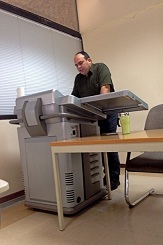See the Syllabus of the coure - Available in pdf format - You need a password for access (download)
Course slides, Homework and assessment problems, couse support, and exercises are available in pdf format. You need a password for acess (Click Here).
See the tab Syllabus of the coure (available in pdf format).
Below you find answers to many questions that may raise by the students. Other important rules and regulations are highlighted. All the students should read carefully the following instructions. Please note that the Lecturer will not respond to any question that is already responded below. The students are encouraged to use the web form, given in the bottom of this web page, to communicate easily with the Lecturer. However, your queries should be clear and concise. Full information about the student should be given in any correspondence.
- The office hours, office location, and my personal contact information are given above. The students can also set appointments in case of emergency.
- The students must pay attention to the presentations of their projects and course work if any. Unclear hand writing will not be corrected. During any exam, duplicated answers for the same question will not be corrected.
- The students are encouraged to participate in class and provide meaningful suggestions to improve the course.
- All the assignments/projects should be given to the Instructor as hard copies. Soft copies are not accepted whatever the reasons are.
- During the examination time, every student must seat in a separate individual table. Cell-phones should be put off during the exams. Students please note that academic dishonesty (or cheating) includes but is not limited to plagiarism, collusion, falsification, replication, taking unauthorized notes or devices into an examination, obtaining an unauthorized copy of the examination paper, communicating or trying to communicate with another candidate during the examination, and being a party to impersonation in relation to an examination.
- Students that are absent in ANY exam are required to give the department/Instructor a justification. Otherwise, an automatic failure is recorded.
- The instructor is not responsible to inform the students about the date of the final exam.
- Refer to the Instructor guide books/files for course delivery guidelines.
- Absences will be noted during the trimester. However, the students must always refer to the web page of the course to download any suggested reading document.
- The Instructor is not obliged to redo lectures or tutorials for those who shall be absent in one or more lectures.
- The students must assure that they have provided their personal emails to the Instructor or the registrar office. Otherwise, the students run the risk to lose communication between the Instructor and the students enrolled in the course.
No project for this course.
The following software are available.
- Multisim is a software for simulation and circuit design. It gives engineers the advanced analysis and design capabilities to optimize performance, reduce design errors, and shorten time to prototype. Intuitive NI tools result in saved printed circuit board (PCB) iterations and significant cost savings (read more).
- Matlab/Simulink is a set of numerical software from Mathworks. Matlab is the language of technical computing. Millions of engineers and scientists worldwide use MATLAB® to analyze and design the systems and products transforming our world. MATLAB is in automobile active safety systems, interplanetary spacecraft, health monitoring devices, smart power grids, and LTE cellular networks. It is used for machine learning, signal processing, image processing, computer vision, communications, computational finance, control design, robotics, and much more (read more). Simulink provides a graphical editor, customizable block libraries, and solvers for modeling and simulating dynamic systems. It is integrated with MATLAB®, enabling you to incorporate MATLAB algorithms into models and export simulation results to MATLAB for further analysis (read more). Simscape™ Power Systems™ Specialized Technology allows you to build and simulate electrical circuits containing linear and nonlinear elements (read more).
- PSpice is a full featured analog circuit simulator with support for digital elements. It integrates easily with Cadence PCB schematic entry solutions and comes with an easy-to-use graphical user interface that equips the user with complete design process control to help solve virtually any design challenge from high-frequency systems to low-power IC designs. Due to its wide popularity, PSpice models, as well as built-in mathematical functions and behavioral modeling techniques, are available from many IC vendors (read more).
- PartSim is a free on-line availabe software. PartSim includes a full SPICE simulation engine, web-based schematic capture tool, and a graphical waveform viewer (read more).
Use the web form below for correspondence. You can also write your interests to the instructor: sibrir@kfupm.edu.sa.
More information about the profile and the research activities of the Instructor are given in the web site.
First, contact me by email to see your preferences. Final projects are subject to the department approval.
Content 2

